| Before plunging into the Site window, you should define your site, which is done in the Site Definition dialog box. If you are a graphical thinker, you may prefer to read Section 6.3 later in this chapter, to see how the Site window looks and operates, before returning here. As discussed in that section, you can view the Site window in several different ways. Whereas "creating" a site entails building HTML pages, "defining" a site tells Dreamweaver to treat your collection of pages as part of a larger whole. Although you can define your site at any time, the earlier you do so, the sooner you can take advantage of Dreamweaver's site management features.  | Whether you start a new site or manage an existing site with Dreamweaver for the first time, the site definition procedure is the same. Dreamweaver can manage any set of files contained in a single local development folder and its subfolders (see Section 6.6 later in this chapter). | | Create a separate site definition for each site you want Dreamweaver to manage. Site definitions can be created and edited under Site  Define Sites (and you can switch between existing sites using Site Define Sites (and you can switch between existing sites using Site  Open Site). When defining a site, you specify such things as its home page, local directory, remote directory, access method, server configuration, and file tracking method. Open Site). When defining a site, you specify such things as its home page, local directory, remote directory, access method, server configuration, and file tracking method. To define a new site, use Site  New Site to open the Site Definition dialog box shown in Figure 6-2. This dialog box's options are broken down into five categories (listed on the left side and discussed in the following sections). Additional site preferences can be configured under Edit New Site to open the Site Definition dialog box shown in Figure 6-2. This dialog box's options are broken down into five categories (listed on the left side and discussed in the following sections). Additional site preferences can be configured under Edit  Preferences Preferences  Site. Site. Figure 6-2. The Local Info category of the Site Definition dialog box 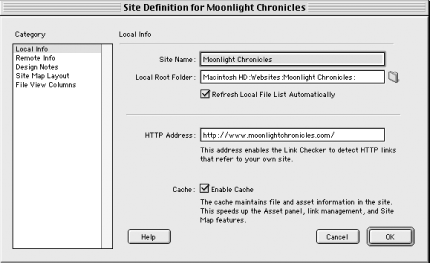 6.2.1 Local Info Category The Local Info category of the Site Definition dialog box, seen in Figure 6-2, includes the options that tell Dreamweaver about the development version of your site residing on your local computer. The Local Info category options are as follows . - Site Name
-
A name of your choice used to identify the site in Dreamweaver; this name appears under Site  Define Sites and in the Site pop-up menu in the Site window. Define Sites and in the Site pop-up menu in the Site window. - Local Root Folder
-
The location of the top-level folder for the site on the local machine (technically, the "local" folder could also be a networked drive). This folder should contain the Home Page, as set under the Site Map Layout category of the same dialog box. All files for a web site, including HTML files, GIF files, etc., should be placed in this folder or in subfolders beneath it. (If you link to any files outside this folder, Dreamweaver prompts you to copy the assets there.)  | Whether starting a new site or managing an existing site with Dreamweaver for the first time, your Local Root Folder location should be the folder containing your home page. If your Local Root Folder pathname includes a forward (/) or backward slash (\) character on the Macintosh, it confuses Dreamweaver and prevents you from using the Site Map feature. | | - Refresh Local File List Automatically
-
If enabled, Dreamweaver automatically refreshes the Site window's local file list when copying files from the web server to the local drive. - HTTP Address
-
The Internet address of the web site, such as http://www.yourdomain.com . This setting allows the Link Checker to determine if an absolute URL refers to a file within the site or to an external site. - Cache
-
Enable this option to maintain a local cache file that speeds up the Assets panel, link management, and the Site Map view. 6.2.2 Remote Info Category The Site Definition dialog box's Remote Info category defines the configuration of the remote server where your live site is published. The appearance of the Remote Info category pane varies, depending on the choice made for the Server Access option. Figure 6-3 shows its appearance when FTP access is selected. Figure 6-3. The Remote Info category of the Site Definition dialog box showing options for FTP access 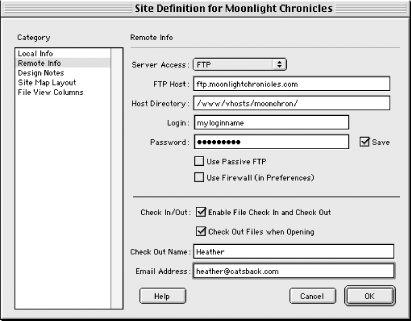 6.2.2.1 Access choice The Server Access field has five options: - None
-
Choose None if you do not plan to upload your site to a server or if you don't yet have the detailed information required when using the other options. - FTP
-
Use FTP access (shown in Figure 6-3) if you upload files to your web server via FTP, such as when using a typical dialup or DSL connection. You'll need additional information provided by your ISP or webmaster to complete the configuration as described in the next section. - Local/Network
-
Choose Local/Network access if your web server is a machine on your local network, such as when publishing for an intranet. Instead of literally uploading files to a remote site, they'll simply be copied to the appropriate directory across the network. - SourceSafe Database
-
Choose SourceSafe Database access if you're using Microsoft's Visual SourceSafe project tracking database software to collaborate with your development team. - WebDAV
-
Choose WebDAV access if you're using a file-tracking and version-control system based on the Web-based Distributed Authoring and Versioning open standard.  | If using the SourceSafe Database or WebDAV options, you should obtain the free Dreamweaver 4.01 update from http://www.macromedia.com/support/dreamweaver/downloads/. | | 6.2.2.2 FTP access If you've chosen FTP access in the Remote Info category of the Site Definition dialog box (shown in Figure 6-3), you'll need to supply the following information to tell Dreamweaver how to reach the FTP server. If you've used an FTP program to transfer files in the past, use those same settings here for Dreamweaver's FTP access: - FTP Host
-
Specify the address of FTP server, usually in the form ftp.someserver.com or www.someserver.com , not simply someserver.com . Don't include any subdirectories, slashes , or @ signs, and don't include the ftp protocol, such as in ftp://ftp.someserver.com . If your server doesn't use the default FTP port (26) specify the FTP port, such as ftp.someserver.com : portNum . The ftp server name may or may not match your domain name; ask your webmaster or ISP if you're unsure. - Host Dir
-
Specify the path of the folder that, with the FTP Host specified earlier, points to your site's root directory on the remote server (i.e., the one that contains your home page). The path may be something like /www/htdocs/ , /virtual_html/ , or /home/yourdomain/ . Ask your ISP or webmaster what folder is assigned for this purpose. You must specify an existing folder on the remote site for the Host Dir. If necessary, specify another folder temporarily, create a new folder in the Remote Files pane of the Site window, and assign it as the Host Dir afterwards. - Login
-
Provide the login name for accessing the FTP server; this name may not be the same login name that you use to access email from your ISP. - Password
-
Provide the FTP account password. Check the Save option so you don't have to keep retyping your password (although you risk someone else gaining access to your site if you share a computer or lose your laptop). - Use Passive FTP
-
Enable this option if your firewall allows passive FTP access only (ask your webmaster). - Use Firewall
-
Enable this option if you connect to the remote server from behind a firewall. (Configure the firewall options under Edit  Preferences Preferences  Site.) Site.) The following options control how Dreamweaver tracks which files are in use. All developers on a collaborative team should use File Check In/Check Out. To check out a file means to take ownership of it and prevent other users from making changes to it while you make changes. To checkin a file means to submit your revisions and relinquish exclusive control of the file. - Enable File Check In and Check Out
-
Enable this option to use Dreamweaver's built-in file tracking system. The next three options appear only if this checkbox is enabled. - Check Out Files when Opening
-
Enabling this option causes Dreamweaver to check out a file whenever it is opened, which ensures that you don't edit a locked file. If this option is disabled, Dreamweaver prompts you whether to View or Check Out the file when you attempt to open a locked file. - Check Out Name
-
Provide your name so others know to contact you if you've checked out a file but never checked it back in. - Email Address
-
Provide your email address so other team members can contact you via email if you've checked out a file but never checked it back in. 6.2.2.3 Local/Network access If you've chosen Local/Network access in the Remote Info category of the Site Definition dialog box (not shown in Figure 6-3) you'll need to supply the following information to tell Dreamweaver where to copy the files over the network for publication. - Remote Folder
-
Provide the path to the network server directory that acts as the root folder for your remote site. This path might look like G:/www/public_html/foobar/ (ask your webmaster or network administrator). - Refresh Remote File List Automatically
-
Enable this option to refresh the Remote Files pane of the Site window whenever files are transferred from the Local Files list. When using Local/Network access, the File Check In and Check Out options are the same as when using FTP access (described in the previous section). Use of Local/Network access does not require a Dreamweaver password setting. That said, to copy files to your network server, you should log into your network prior to starting Dreamweaver. 6.2.2.4 SourceSafe Database access Visual SourceSafe is a sophisticated project tracking software package from Microsoft. If you've chosen SourceSafe Database access in the Remote Info category of the Site Definition dialog box (not shown in Figure 6-3), you'll need Dreamweaver 4.01 plus access to a Visual Source Safe (VSS) server and a VSS database. Windows users must also install Version 6 or later of Microsoft's VSS Client. Macintosh users must install the Metrowerks VSS client as described at: - http://www.macromedia.com/support/dreamweaver/site/source_safe_mac/
- http://www.macromedia.com/support/dreamweaver/ts/documents/vss_on_mac.htm
These SourceSafe configuration options are accessed using the Settings button in the Remote Info category of the Site Definition dialog box (not shown). Ask your SourceSafe administrator for assistance. - Database Path
-
Specifies the path to the SourceSafe database's srcsafe.ini file that Dreamweaver uses to initialize SourceSafe integration. - Project
-
Provides the name of your project within the SourceSafe database (a single database can manage multiple projects). - Username
-
Provides your SourceSafe account username. - Password
-
Provides your SourceSafe account password. Enable the Save option if you don't want to keep retyping your password. The final option determines how Dreamweaver integrates its File Check In/Check Out feature with SourceSafe. - Check Out Files when Opening
-
You should enable this option to allow Dreamweaver's File Check In/Check Out feature to work cooperatively with SourceSafe. You need not supply identifying information because Dreamweaver uses your SourceSafe identity. 6.2.2.5 WebDAV access WebDAV is an open standard for file tracking and version control supported by some web servers. If you've chosen WebDAV access in the Remote Info category of the Site Definition dialog box (not shown in Figure 6-3), you'll need Dreamweaver 4.01 plus access to a WebDAV-compatible server, such as Microsoft IIS 5.0 or the Apache Web Server. The WebDAV configuration options are accessed using the Settings button in the Site Definition dialog box (not shown). Ask your WebDAV administrator for assistance. - URL
-
The URL of the root folder on the WebDAV server, beginning with http:// . - Username
-
Provides your WebDAV account username. - Password
-
Provides your WebDAV account password. Enable the Save Password option if you don't want to keep retyping your password. - Email
-
Provides your email address to be used within WebDAV. The final option determines how Dreamweaver integrates its File Check In/Check Out feature with WebDAV. - Check Out Files when Opening
-
You should enable this option to enable Dreamweaver's File Check In/Check Out feature to work cooperatively with WebDAV. You need not supply identifying information because Dreamweaver uses your WebDAV identity. 6.2.3 Design Notes Category Design Notes provide a means to track extra file information associated with web site documents, such as the location of original artwork or comments regarding a file's status. The options available under the Design Notes category of the Site Definition dialog box are shown in Figure 6-4. Figure 6-4. The Design Notes category of the Site Definition dialog box 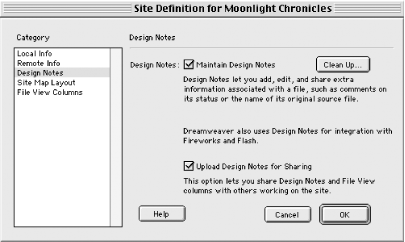 Design Notes are ideal for collaboration but act as useful reminders even if you work alone. They are used for Fireworks and Flash integration and therefore should be turned on in most cases. See Section 6.5 later in this chapter for more details. The dialog box options are as follows. - Maintain Design Notes
-
You should enable Design Notes to take advantage of their many benefits, including File View column sharing as described under Section 6.2.5. - Cleanup
-
Use the Cleanup button to delete Design Notes associated with files that have been deleted. (Dreamweaver handles this task for you if you delete files using the Site window.) - Upload Design Notes for Sharing
-
Enable this option to upload Design Notes to the web server for sharing with other collaborators. The notes are not made available to web site visitors . This option must be enabled to support File View column sharing as described in Section 6.2.5 later in this chapter. 6.2.4 Site Map Layout Category The Site Map Layout category of the Site Definition dialog box, shown in Figure 6-5, controls the site map's display (shown in Figure 6-9). This dialog box can be opened easily using View  Layout in the Site window (Windows) or Site Layout in the Site window (Windows) or Site  Site Map View Site Map View  Layout (Macintosh); however, these menu options work only when the Site Map view is open. Layout (Macintosh); however, these menu options work only when the Site Map view is open. Figure 6-5. The Site Map Layout category of the Site Definition dialog box 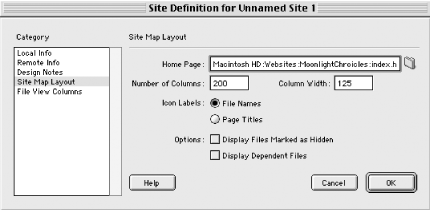 The Site Map Layout options are described next. The most important item is the Home Page option; if it is set incorrectly, you won't be able to access the Site Map view in the Site window. - Home Page
-
Provides the path to the site's home page, which should be located in the Local Root Folder as specified under the Local Info category of the same dialog box. If you haven't created your home page yet, leave this option blank and set it later using Site  Set as Home Page in the Site window (Windows) or Site Set as Home Page in the Site window (Windows) or Site  Site Map View Site Map View  Set as Home Page (Macintosh). Set as Home Page (Macintosh).  | If managing an existing site for the first time in Dreamweaver, simply browse to your home page in your site's root folder. If the path to your home page includes a forward (/) or backward slash (\) character on the Macintosh, it will confuse Dreamweaver and prevent you from using the Site Map feature. | | - Number of Columns
-
Specifies the number of file icons to display per row in the site map. If this number if large, the site map may be very wide. If the number is small, the site map will require more vertical space in the Site Map window. - Column Width
-
Specifies the spacing between columns in the site map (between 70 and 1,000 pixels). If the width is too narrow, items may be too crowded to readbut the width of individual columns can be set by clicking and dragging the vertical arrows in the Site Map window (see Figure 6-9). Use the Zoom pop-up menu in the lower-left corner of the Site window to change the site map's magnification. - Icon Labels
-
Specifies whether to display filenames or document titles below the icons in the Site Map view. Toggle this option using Ctrl+Shift+T (Windows) or Cmd+Shift+T (Macintosh). You can also run a report to detect untitled documents. The Site Files pane always shows filenames, but a document's title is shown at the bottom of the Site window when you roll over its name in the file list. - Display Files Marked as Hidden
-
Determines whether all files marked as hidden should be omitted from the site map. This option is also available under View  Show Files Marked as Hidden in the Site window (Windows) or Site Show Files Marked as Hidden in the Site window (Windows) or Site  Site Map View Site Map View  Show Files Marked as Hidden (Macintosh). To mark an individual file as hidden, use Show/Hide Link from the contextual menu in the Site window, Ctrl+Shift+Y (Windows), or Cmd+Shift+Y (Macintosh). When hidden files are displayed, their names are shown in italics. Show Files Marked as Hidden (Macintosh). To mark an individual file as hidden, use Show/Hide Link from the contextual menu in the Site window, Ctrl+Shift+Y (Windows), or Cmd+Shift+Y (Macintosh). When hidden files are displayed, their names are shown in italics. - Display Dependent Files
-
Determines whether to show dependent files (such as GIFs, JPEGs, and PNGs) embedded within each web page. If this option is disabled, only the files that are connected via hyperlinks are shown in the site map. 6.2.5 File View Columns Category The File View Columns category of the Site Definition dialog box, shown in Figure 6-6, controls the appearance of the Site Files view (shown in Figure 6-14). This dialog box can be opened by choosing View  File View Columns in the Site window (Windows) or Site File View Columns in the Site window (Windows) or Site  Site Files View Site Files View  File View Columns (Macintosh). File View Columns (Macintosh). Figure 6-6. The File View Columns category of the Site Definition dialog box 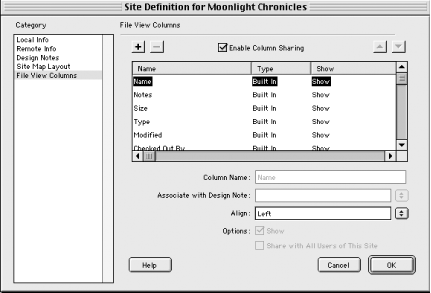 The File View Columns options are described next. They can be used to show the file's name, modification date, and type, and even information from Design Notes. - Enable Column Sharing
-
Enabling this option allows new columns you define to be shared by other users on your development team. It also allows you to access shared columns that other users have created. After enabling sharing, you can designate specific columns to be shared using the Share with All Users of This Site option. To share columns, Design Note sharing must be enabled in the Design Notes category of the same dialog box. - Column List
-
The items (rows) in the scrolling Column List configure the columns shown in the Site Files window (i.e., the row labeled Notes controls the Notes column in the Site Files window as shown in Figure 6-14). Don't confuse these columns with the Name, Type, and Show columns in the Column List itself. Select an item in the Column List to set its individual properties. Add a Personal (i.e., custom) item by clicking the plus (+) button (see Figure 6-6). Clicking the minus (-) button will delete an item without warning (but items can be recreated easily). The built-in items Name, Notes, Size, Type, Modified, and Checked Out By cannot be deleted (however, all but the Name column can be hidden). Use the up and down arrow buttons to control the order of the rows, which determines the order of the columns in the Site Files window. The Checked Out By column is useful for tracking who has a file checked out when using Dreamweaver's File Check In/Check Out feature. The following five options apply to each item in the Column List (although some can't be changed for built-in items): - Column Name
-
A new name of your choice for the custom column when displayed in the Site Files view. The names of built-in columns cannot be changed. - Associate with Design Note
-
This option's name is misleading. It allows data entered in Design Notes to be displayed in the custom columns you've defined for the Site Files window. For now, you can choose Status, which is one of the predefined fields (pieces of data) that can be extracted from Design Notes. See the discussion under Section 6.5 later in this chapter for details on displaying other data, including the assigned, due, and priority fields. (Fields are also known as name/value pairs. ) - Align
-
Controls the alignment (Left, Right, or Center) of column data. - Show
-
Use this checkbox to show or hide the selected column in the Site Files view. The built-in Names column cannot be hidden, but this option is useful for hiding the other built-in columns, which cannot be deleted. - Share with All Users of This Site
-
Enable this option to make this column available to other users who have enabled sharing. This option lets you selectively share columns, provided that Enable Column Sharing is enabled. The built-in columns are always shared by all users. Once you've finished defining your site, click OK in the Site Definition dialog box. 6.2.6 Editing a Previously Defined Site Editing a previously defined site is not the same thing as creating a site definition to manage an existing site in Dreamweaver for the first time.  | To create a site definition for an existing site, see Section 6.6 later in this chapter. | | To transfer site definition files between computers, use the Site Import Export extension available from the Dreamweaver Exchange (as explained in Chapter 22). Dreamweaver 4 reads site definitions from earlier versions of Dreamweaver. To edit an existing site definition, choose Site  Define Sites, which opens the Define Sites dialog box, shown in Figure 6-7. Define Sites, which opens the Define Sites dialog box, shown in Figure 6-7. Figure 6-7. The Define Sites dialog box 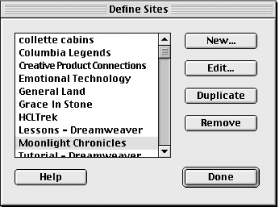 From this dialog box you have four options: - New
-
Creates a new site definition (same as Site  New Site). New Site). - Edit
-
Edits an existing site definition. - Duplicate
-
Duplicates an existing site definition to use as the basis for a new one. Be sure to change the Local Root Folder and HTTP Address under the Local Info category, the remote server settings under the Remote Info category, and the Home Page under the Site Map Layout category. If two sites share the same Local Root Folder, Dreamweaver's file management and synchronization features may not work properly. - Remove
-
Deletes an existing site definition. Deleting a site definition does not delete HTML and asset files within the site, but it does delete Design Notes. Note that the Site  Open Site command is not used to edit a site definition; instead, it "loads" an existing site definition, allowing you to switch between web site projects. You can also switch sites using the Site pop-up menu in the toolbar of the Site window (see Figure 6-8). Open Site command is not used to edit a site definition; instead, it "loads" an existing site definition, allowing you to switch between web site projects. You can also switch sites using the Site pop-up menu in the toolbar of the Site window (see Figure 6-8).  | Double-click the current site's name in the Site pop-up menu in the Site window's toolbar to quickly open the current site definition for editing. | | 6.2.7 Creating a New Site from Scratch If you have an existing collection of web pages, you can create a new site definition for them by using the procedures described earlier in this chapter under Section 6.2. Section 6.2.7.1 shows how to define a site before creating your web pages. 6.2.7.1 Procedure 2 -
Choose Site  New Site. New Site. -
Under the Local Info category of the Site Definition dialog box, specify the site's home directory in the Local Root Folder field. You can browse to an existing folder, or even create a new folder from within the folder selection dialog box, as indicated in Figure 6-1. -
Set the options under the other categories of the Site Definition dialog box as desired. At a minimum, specify the remote server access information under the Remote Info category; you can temporarily set the Server Access to None if you don't have the information handy. -
You can leave the Home Page field under the Site Map Layout category blank for now; we'll set it during Step 9. -
Click OK to save the site definition for this site. Dreamweaver will open the Site Files view of the Site window. -
Use File  New Window in the Site window (Windows) or File New Window in the Site window (Windows) or File  New (Macintosh) to open an untitled Document window. Use File New (Macintosh) to open an untitled Document window. Use File  Save As to immediately save the file as home.html in the site's local root folder, as defined in Step 2. (The filename home.html is an example. Your web server may prefer home.htm , index.html , index.htm , default.html , or default.htm .) Save As to immediately save the file as home.html in the site's local root folder, as defined in Step 2. (The filename home.html is an example. Your web server may prefer home.htm , index.html , index.htm , default.html , or default.htm .) -
Add whatever content you like to the home page using the Document window, Objects panel, etc. Dreamweaver may prompt you to copy dependent files, such as GIFs, to the site's local root folder. Resave the document. -
Use Window  Site Files (F8) to return to the Site Files window. Your new home.html file should appear in the Local Files pane on the right side of the window. Site Files (F8) to return to the Site Files window. Your new home.html file should appear in the Local Files pane on the right side of the window. -
Select the home.html file in the Local Files list by clicking it once. Then choose Site  Set as Home Page in the Site window (Windows) or Site Set as Home Page in the Site window (Windows) or Site  Site Map View Site Map View  Set as Home Page (Macintosh) to tell Dreamweaver to use this file as the site's home page. Set as Home Page (Macintosh) to tell Dreamweaver to use this file as the site's home page. -
Click and hold the Site Map button in the Site window's toolbar (see Figure 6-9), and choose the Map and Files option. Your home page should appear on the left in the Site Map pane of the Site window. The right pane should continue to show the Local Files list. Congratulations! You've set up your site and defined its home page. See the next section for details on using the Site window to build and manage sites. |






